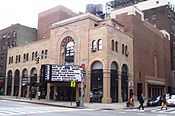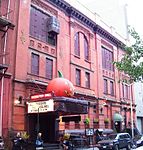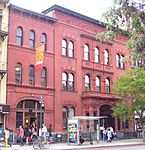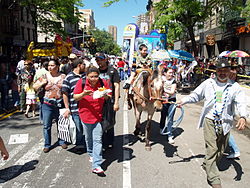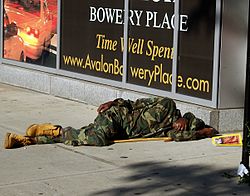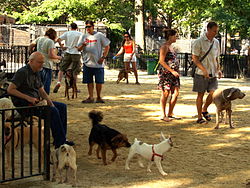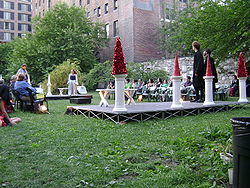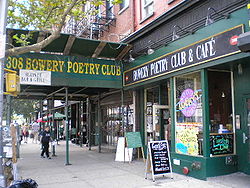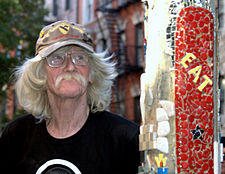- East Village, Manhattan
-
Coordinates: 40°43′39″N 73°59′09″W / 40.7275°N 73.98583°W
East Village, Manhattan New York City Neighborhood 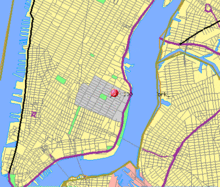
Location in Lower ManhattanNamed: 1960s[1] Streets: 2nd Avenue, First Avenue (Manhattan)1st Avenue, Avenue A, the Bowery, St. Marks Place Subway: Second Avenue (F train), Astor Place (4 6 <6> trains) and First Avenue (L train) Zip code: 10009, 10003 and 10002 Government Federal: Congressional Districts 8, 12 and 14 State: New York State Assembly Districts 64, 66 and 74, New York State Senate Districts 25 and 29 City: New York City Council District 2 Local Manhattan Community Board 3 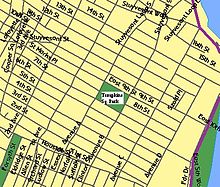
Neighborhood map The East Village is a neighborhood in the borough of Manhattan in New York City, lying east of Greenwich Village, south of Gramercy and Stuyvesant Town, and north of the Lower East Side. Within the East Village are several smaller neighborhoods, including Alphabet City and the Bowery.
The area was once generally considered to be part of the Lower East Side, but began to develop its own identity and culture in the 1960s, when many artists, musicians, students and hippies began to move into the area, attracted by cheap rents and the base of Beatniks that had lived there since the 1950s. The neighborhood has become a center of the counterculture in New York, and is known as the birthplace and historical home of many artistic movements, including punk rock[2] and the Nuyorican literary movement.[3] It has also been the site of protests and riots.
The East Village is still known for its diverse community, vibrant nightlife and artistic sensibility, although in recent decades gentrification has changed the character of the neighborhood somewhat.[4]
Contents
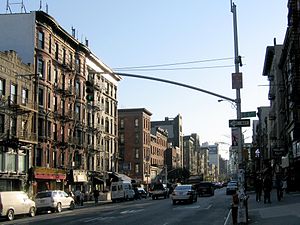 Looking south from East 6th Street down Second Avenue, one of the main thoroughfares through the East Village
Looking south from East 6th Street down Second Avenue, one of the main thoroughfares through the East Village
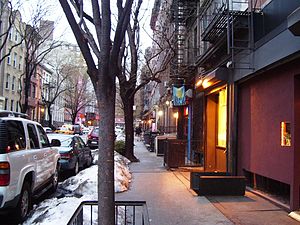 East 5th Street between Second Avenue and Cooper Square is a typical side street in the heart of the East Village
East 5th Street between Second Avenue and Cooper Square is a typical side street in the heart of the East Village
Boundaries
Definitions vary,[5] but generally the East Village is considered to be the area east of Broadway and the Bowery to the East River, between 14th Street and Houston Street.[1]
History
Background
See also: Ukrainian Americans in New York CityThe area that is today known as the East Village was originally a farm owned by Dutch Governor-General Wouter van Twiller. Petrus Stuyvesant received the deed to this farm in 1651, and his family held on to the land for over seven generations, until a descendant began selling off parcels of the property in the early 19th century. Wealthy townhouses dotted the dirt roads for a few decades until the great Irish and German immigration of the 1840s and 1850s.
Speculative land owners began building multi-unit dwellings on lots meant for single family homes, and began renting out rooms and apartments to the growing working class, including many immigrants from Germany. From roughly the 1850s to first decade of the 20th century, the neighborhood has the largest urban populations of Germans outside of Vienna and Berlin, and was known as Klein Deutschland ("Little Germany"). It was America's first foreign language neighborhood; hundreds of political, social, sports and recreational clubs were set up during this period, some of these buildings still exist. However, the vitality of the community was sapped by the General Slocum disaster on June 15, 1904, in which over a thousand German-American died.
Later waves of immigration also brough many Poles and, especially, Ukrainians to the area. Since the 1890s there has been a large concentration roughly from 10th Street to 5th Street, between 3rd Avenue and Avenue A. The post-World War II diaspora, consisting primarily of Western Ukrainian intelligentsia, also settled down in the area. Several churches, including St. George's Catholic Church; Ukrainian restaurants and butcher shops; The Ukrainian Museum; the Shevchenko Scientific Society; and the Ukrainian Cultural Center are evidence of the impact of this culture on the area.
The area originally ended at the East River, where Avenue C is now located, until landfill—including World War II debris and rubble shipped from London—was used to extend the shoreline outward to provide foundation for the Franklin D. Roosevelt Drive.[6]
A new neighborhood
Until the mid-1960s, the area was simply the northern part of the Lower East Side, with a similar culture of immigrant, working class life. In the 1950s the migration of Beatniks into the neighborhood later attracted hippies, musicians and artists well into 1960s.[1] The area was dubbed the "East Village", to dissociate it from the image of slums evoked by the Lower East Side. According to The New York Times, a 1964 guide called Earl Wilson's New York wrote that "artists, poets and promoters of coffeehouses from Greenwich Village are trying to remelt the neighborhood under the high-sounding name of 'East Village.'"[1]
Newcomers and real estate brokers popularized the new name, and the term was adopted by the popular media by the mid-1960s.[7][8] In 1966 a weekly newspaper, The East Village Other, appeared and The New York Times declared that the neighborhood "had come to be known" as the East Village in the June 5, 1967 edition.[1]
 Patti Smith, seen here in Copenhagen in 1976, is one of the many poets, musicians and artists who got their start in the East Village[9]
Patti Smith, seen here in Copenhagen in 1976, is one of the many poets, musicians and artists who got their start in the East Village[9]
The music scene develops
In 1966 Andy Warhol promoted a series of multimedia shows, entitled "The Exploding Plastic Inevitable", and featuring the music of the Velvet Underground, in a Polish ballroom on St. Marks Place. On June 27, 1967, the Electric Circus opened in the same space with a benefit for the Children's Recreation Foundation whose chairman was Bobby Kennedy. The Grateful Dead, The Chambers Brothers, Sly and the Family Stone and the Allman Brothers were among the many rock bands that performed there before it closed in 1971.
On March 8, 1968 Bill Graham opened the Fillmore East in what had been a Yiddish Theatre on Second Avenue at East 6th Street. The venue quickly became known as "The Church of Rock and Roll", with two-show concerts several nights a week. While booking many of the same bands that had played the Electric Circus, Graham particularly used the venue—and its West Coast counterpart—to establish new British bands like The Who, Pink Floyd, The Jimi Hendrix Experience, Cream, and Led Zeppelin. The Fillmore East also closed in 1971.
CBGB, the nightclub considered by some to be the birthplace of punk music, was located in the neighborhood, as was the early punk standby A7. No Wave and New York hardcore also emerged in the area's clubs. Among the many important bands and singers who got their start at these clubs and other venues in downtown Manhattan were Patti Smith, Arto Lindsay, the Ramones, Blondie, Madonna, Talking Heads, Television, the Plasmatics, Glenn Danzig, Sonic Youth, the Beastie Boys, Anthrax, and The Strokes.
Some icons of the punk scene remained in the neighborhood as it changed. Richard Hell lives in the same apartment he has lived in since the 1970s, and Handsome Dick Manitoba of The Dictators owns and reigns over Manitoba's bar on Avenue B.
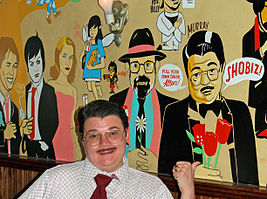 Performer Murray Hill with the "Downtown Legends" wall at Mo Pitkins House of Satisfaction, depicting artists of the East Village performance scene, including the Reverend Jen, Nick Zedd, Allen Ginsberg, Reverend Billy
Performer Murray Hill with the "Downtown Legends" wall at Mo Pitkins House of Satisfaction, depicting artists of the East Village performance scene, including the Reverend Jen, Nick Zedd, Allen Ginsberg, Reverend Billy
The art scene
Over the last 100 years, the East Village and the Lower East Side have contributed significantly to American arts and culture in New York.[10] The neighborhood has been the birthplace of cultural icons and movements from the American gangster to the Warhol Superstars, folk music to punk rock, anti-folk to hip-hop, advanced education to organized activism, experimental theater to the Beat Generation and the community of experimental musicians, composers and improvisers now loosely known as the Downtown Scene.
Club 57, on St. Marks Place, was an important incubator for performance art and visual art in the late 1970s and early 1980s; followed by Now Gallery, 8BC and ABC No Rio.
During the 1980s the East Village art gallery scene helped to galvanize a new post-modern art in America; showing such artists as Kiki Smith, Peter Halley, Keith Haring, Stephen Lack, Greer Lankton, Joseph Nechvatal, Nan Goldin, Jean-Michel Basquiat, David Wojnarowicz, James Romberger, Rick Prol, and Jeff Koons.
Decline of the art scene
The East Village's performance and art scene has declined since its heyday in the 1970s and 1980s.[11] One club that had opened to try to resurrect the neighborhood's past artistic prominence was Mo Pitkins' House of Satisfaction, part-owned by Jimmy Fallon of Saturday Night Live. It closed its doors in 2007, and was seen by many as another sign of the continued decline of the East Village performance and art scene, which has shifted in part to Williamsburg in Brooklyn.[12] Rapture Cafe also shut down in April 2008, and the neighborhood lost an important performance space and gathering ground for the gay community. There are still some performance spaces, such as Sidewalk Cafe on Avenue A, where downtown acts find space to exhibit their talent, and the poetry clubs.[13]
From 2004 until 2009, the art gallery American Painting, located on East 6th St., between 2nd and 3rd Avenues, exhibited the works of several New York and American artists, namely, Andrei Kushnir, Michele Martin Taylor, Carol Spils, Barbara Nuss, Joachim Marx, Stevens Jay Carter and Michael Francis. One of their last exhibits, "East Village Afternoon," depicted local interiors, exteriors, and scenes of the changing neighborhood.[14]
Rent
The East Village is the setting for Jonathan Larson's musical Rent, which captures the neighborhood in the early 1990s; it opened at the New York Theater Workshop in February 1996.[15] Rent describes a city devastated by the AIDS epidemic, drugs and high crime, and follows several characters in their efforts to make livings as artists.[16]
Gentrification
As has often been the pattern in Manhattan, a neighborhood that is "discovered" by artists and bohemians and then becomes "hip", will often begin to attract more affluent residents, which drives up the price of housing, and begins to drive out some of the very people who "turned over" the neighborhood. This process, called gentrification, has occurred in SoHo, TriBeCa and Williamsburg in Brooklyn. Over the course of time, it begins to change the essential character of the neighborhood, which becomes safer, more comfortable and less "edgy".
Preservation
Many local community groups actively worked and are working to gain individual and district landmark designations for the East Village to preserve and protect the architectural and cultural identity of the neighborhood. One such group is the Greenwich Village Society for Historic Preservation. They have undertaken a complete survey of the East Village, documenting the history of every single building in the area.[17] This information will be made public in the fall of 2011. In the spring of 2011 the Landmarks Preservation Commission proposed two East Village Historic Districts, one small district covering the block of East 10th Street known as Tompkins Square North and one larger district focused around lower Second Avenue that would encompass 15 blocks and 330 buildings.[18] The original proposal for the larger district excluded buildings such as the Pyramid Club and the Russian Orthodox Cathedral on East 2nd Street. Thanks to efforts made by local community groups such as the Lower East Side Preservation Initiative, East Village Community Coalition, Historic Districts Council, and Greenwich Village Society for Historic Preservation, however, the proposed district now includes these worthy buildings.[19] The districts are calendared to go up before the entire Landmarks Preservation Commission, but a hearing has yet to be scheduled.
Some of the individual sites that are already protected by landmark status are: PS 64/Old Charas Cultural Center,[20] the former Yiddish Art Theater,[21] Webster Hall, which was designated a New York City landmark on March 18, 2008,[22] and Stuyvesant Polyclinic, one of the East Village's earliest designated landmarks.[23] Some specific sites that are still in need of landmark designation are: the Russian Orthodox Cathedral,[24] 101 Avenue A, the current home of the Pyramid Club,[25] 128 East 13th Street, a former horse auction market and home to Frank Stella's studio,[26] the 170-year old rowhouses at 326-328 East 4th Street,[27] and the Congregation Mezritch Synagogue, the East Village's last operating tenement synagogue.[28]
New York University
Along with gentrification, the East Village has seen an increase in the number of buildings owned and maintained by New York University, particularly dormitories for undergraduate students, and this influx has given rise to conflict between the community and the university.[29]
St. Ann's Church, a rusticated-stone structure with a Romanesque tower on East 12th Street that dated to 1847, was sold to NYU to make way for a 26-story, 700 bed dormitory. After community protest about the destruction of the church, the university promised to protect and maintain the original facade, which it did, literally by having it stand alone in front of the new building, which is the tallest structure in the area.[29] NYU's destruction or purchasing of many historic buildings, such as the Peter Cooper Post Office, have made it symbolic of change that many long-time residents fear is destroying what made the neighborhood interesting and attractive.[30]
NYU has often been at odds with residents of both the East and West Villages; urban preservationist Jane Jacobs battled the school in the 1960s.[31] "She spoke of how universities and hospitals often had a special kind of hubris reflected in the fact that they often thought it was OK to destroy a neighborhood to suit their needs," said Andrew Berman of the Greenwich Village Society for Historic Preservation.[32]
Cooper Union
The Cooper Union for the Advancement of Science and Art, founded in 1859 by entrepreneur and philanthropist Peter Cooper and located on Cooper Square, is one of the most selective colleges in the world, with tuition-free programs in engineering, art and architecture. Its Great Hall is famous as a platform for historic speeches, notably Abraham Lincoln's Cooper Union speech and its New Academic Building is the first in New York City to achieve LEED Platinum Status.
Neighborhoods within the East Village
Once synonymous with 'Bowery Bums', the avenue has become a magnet for luxury condominiums as the neighborhood's rapid gentrification continues
The East Village contains several smaller vibrant communities, each with their own character.
Alphabet City
Alphabet City comprises nearly two-thirds of the East Village, and was once the archetype of a dangerous New York City neighborhood. Its turn-around was cause for The New York Times to observe in 2005 that Alphabet City went "from a drug-infested no man's land to the epicenter of downtown cool."[33] Its name comes from Avenues A, B, C, and D, the only avenues in Manhattan to have single-letter names. It is bordered by Houston Street to the south and 14th Street to the north. Some landmarks with Alphabet City include Tompkins Square Park and the Nuyorican Poets Cafe.
Loisaida
Loisaida is a term derived from the Latino, and especially Nuyorican, pronunciation of "Lower East Side". The term was originally coined by poet/activist, Bittman "Bimbo" Rivas in his 1974 poem "Loisaida". Loisaida Avenue is now an alternative name for Avenue C in the Alphabet City neighborhood of New York City, whose population has largely been Hispanic (mainly Nuyorican) since the late 1960s. During the 1980's many of the old, vacant, tenement buildings in this area became inhabited by squatters.[34]
St. Marks Place
Main article: St. Marks Place (Manhattan)Eighth Street becomes St. Marks Place east of Third Avenue. It once had the cachet of Sutton Place, and was known as a secluded rich enclave in Manhattan, but by the 1850s had become a place for boarding houses and a German immigrant community.[35] It is named after St. Mark's Church in-the-Bowery, which was built on Stuyvesant Street but is now on 10th Street. St. Marks Place once began at the intersection of the Bowery and Stuyvesant Street, but today the street runs from Third Avenue to Avenue A. Japanese street culture and a Japanese expatriate scene forms in the noodle shops and bars that line the street, also home to an aged punk culture and CBGB's new store. It is home to one of the only Automats in New York City (it has since closed).[36]
St. Marks Place is along the "Mosaic Trail", a trail of 80 mosaic-encrusted lampposts that runs from Broadway down Eighth Street to Avenue A, to Fourth Street and then back to Eighth Street. The project was undertaken by East Village public artist Jim Power, known as the "Mosaic Man".[37]
The Bowery
Main article: The BoweryThe Bowery, former home to the punk-rock nightclub CBGB, was once known for its many homeless shelters, drug rehabilitation centers and bars. The phrase "On The Bowery", which has since fallen into disuse, was a generic way to say one was down-and-out.[38]
The Bow’ry, The Bow’ry!
They say such things,
and they do strange things
on the Bow’ry —From the musical A Trip to Chinatown, 1891Today, the Bowery has become a boulevard of new luxury condominiums. It also is home to the Amato Opera and the Bowery Poetry Club, contributing to the neighborhood's reputation as a place for artistic pursuit. Artists Amiri Baraka and Taylor Mead hold regular readings and performances in the space.
The redevelopment of the avenue from flophouses to luxury condominiums has met with resistance from long-term residents, who agree the neighborhood has improved, but that its unique, gritty character is also disappearing.[39]
Parks and green space
 Tompkins Square Park is the recreational and geographic heart of the East Village. It has historically been a part of counterculture, protest and riots.
Tompkins Square Park is the recreational and geographic heart of the East Village. It has historically been a part of counterculture, protest and riots. A production of John Reed's All the World's a Grave in the New York Marble Cemetery, which does not contain headstones
A production of John Reed's All the World's a Grave in the New York Marble Cemetery, which does not contain headstones
Tompkins Square Park
Tompkins Square Park is a 10.5 acre (42,000 m²) public park in the Alphabet City section of the East Village neighborhood in the borough of Manhattan in New York City. It is square in shape, and is bounded on the north by East 10th Street, on the east by Avenue B, on the south by East 7th Street, and on the west by Avenue A. St. Marks Place abuts the park to the west.
Tompkins Square Park Communist Rally
Main article: Tompkins Square Park Communist Rally (1877)In July of 1877, railroad workers received their second wage cut of the year by the Baltimore & Ohio Railroad. On July 14, railroad employees in Martinsburg, West Virginia, began what came to be known as the Great Railroad Strike of 1877. On July 25, 1877, twenty thousand people gathered in Tompkins Square Park to hear communist orators speak about revolution, the strike, and the policies of President Hayes. All speeches were repeated in German at a second stand, as the neighborhood had such a large German population at that time. David Conroy, Chairman of the Working Man's Organization in NYC and organizer of the rally, stated that the purpose of the meeting was to harmonize the differences between the strikers and the railroad companies, and to urge the citizen soldiery to refrain from acting against the strikers. Although the rally did not get out of hand, New York City police and National Guardsmen eventually charged the crowd with billy clubs, later claiming that the rally was not being held in a peaceful manner. In the wake of this “riot,” the City, in conjunction with the War Department, established an official city armory program led by the 7th Regiment.[40]
Tompkins Square Park Police Riot
Main article: Tompkins Square Park Police Riot (1988)The Tompkins Square Park Police Riot was a defining moment for the neighborhood. In the late hours of August 6 into the morning hours of August 7, 1988 a riot broke out in Alphabet City's Tompkins Square Park. Groups of "drug pushers, homeless people and young people known as 'skinheads'" had largely taken over the East Village park, but the neighborhood was divided about what, if anything, should be done about it.[41] The local governing body, Manhattan Community Board 3, adopted a 1 am curfew for the previously 24-hour park, in an attempt to bring it under control.[42] On July 31, a rally against the curfew resulted in several clashes between protesters and police.[43]
East River Park
The park is 57 acres (230,000 m2) and runs between the Franklin D. Roosevelt Drive and the East River from Montgomery Street to East 12th Street.[44] It was designed in the 1930s by Robert Moses, who wanted to ensure there was parkland on the Lower East Side.[44] In 2010, construction was completed on the East River Promenade, which now runs from East 12th Street to Grand Street and continues to be expanded south.[45]
Community gardens
There are reportedly over 640 community gardens in New York City—gardens run by local collectives within the neighborhood who are responsible for the gardens' upkeep—and an estimated 10 percent of those are located on the Lower East Side and East Village alone.[46]
Tower of Toys on Avenue B
The Avenue B and 6th Street Community Garden is one of the neighborhood's more notable for a now removed outdoor sculpture, the Tower of Toys, designed by artist and long-time garden gate-keeper, Eddie Boros. Boros died April 27, 2007.[47] The Tower was controversial in the neighborhood; some viewed it as a masterpiece, others as an eyesore.[47][48] It was a makeshift tower, 65-feet in height, assembled out of wood planks. The suspended, hanging toys were an amalgamation of fanciful objects found on the street (Boros was a strong voice for reusing and recycling). The fantastical, childlike feeling of this installation was quite fitting considering that the garden boasts a children’s adventure playground and children’s garden.[49] The tower appeared in the opening credits for the television show NYPD Blue and also appears in the musical Rent.[47] In May 2008, it was dismantled. According to NYC Parks Commissioner Adrian Benepe, the tower was rotting in sections that made it a safety hazard.[50] Its removal was seen as another symbol of the fading past of the neighborhood.[50]
Toyota Children's Learning Garden
Located at 603 East 11th Street, the Toyota Children's Learning Garden is not technically a community garden, but it also fails to fit in the park category. Designed by landscape architect Michael Van Valkenburgh, the garden opened in May 2008 as part of the New York Restoration Project and is designed to teach children about plants.[51]
Marble Cemeteries
The New York City Marble Cemetery is located on 2nd Street between First Avenue and Second Avenue, and is the second oldest non-sectarian cemetery in New York City. The cemetery was opened in 1831 and at one point contained ex-U.S. President James Monroe.[52] Among those interred there are Stephen Allen, mayor (1821–1824); James Lenox, whose personal library became a part of the New York Public Library; Isaac Varian, mayor (1839–1841); Marinus Willet, Revolutionary War hero; and Preserved Fish, a well-known New York merchant.[52]
Nearby, on Second Avenue between 2nd and 3rd Streets, is the oldest public cemetery in New York City not affiliated with any religion, the New York Marble Cemetery.[53] It is open the fourth Sunday of every month.[54]
Culture
Ethnicity and religion
According to 2000 census figures provided by the New York City Department of City Planning, which includes the Lower East Side in its calculation, the neighborhood was 35% Asian, 28% non-Hispanic white, 27% Hispanic and 7% black.[55]
On October 9, 1966, A.C. Bhaktivedanta Swami Prabhupada, founder of the International Society for Krishna Consciousness, held the first recorded outdoor chanting session of the Hare Krishna mantra outside of the Indian subcontinent at Tompkins Square Park.[56] This is considered the founding of the Hare Krishna religion in the United States, and the large tree close to the center of the Park is demarcated as a special religious site for Krishna adherents.[56] The late poet Allen Ginsberg, who lived and died in the East Village, attended the ceremony.
There are several Roman Catholic churches in the East Village that have fallen victim to financial hardship particularly in the past decade. Unable to maintain their properties, the Roman Catholic Church has shuttered many of them—including St. Mary's Help of Christians on East 12th Street, as well as St. Ann's. There has recently been much controversy over St. Brigid's, the historical parish on Tompkins Square Park.
Cultural institutions
 The Nuyorican Poets Cafe has been located off Avenue C and East 3rd Street since its founding in 1973
The Nuyorican Poets Cafe has been located off Avenue C and East 3rd Street since its founding in 1973
- Libraries
- New York Public Library Tompkins Square branch[57]
- The Fales Library of New York University[58]
- Museums
- Poetry
- Nuyorican Poets Cafe – music, poetry, readings, slams
- Bowery Poetry Club – music, poetry, readings, slams
- Poetry Project – at St. Mark's Church in-the-Bowery
- Music
- Bowery Ballroom – concerts and shows
- Mercury Lounge – live music
- Sidewalk Cafe – performance and live music
- The Stone – experimental music
- Theaters and performance spaces
- Amato Opera
- Bouwerie Lane Theatre
- Danspace Project – at St. Mark's Church in-the-Bowery
- La MaMa E.T.C. – avant-garde theater
- Metropolitan Playhouse[59]
- The Ontological-Hysteric Theater – at St. Mark's Church in-the-Bowery
- The Pearl Theatre Company[60]
- Performance Space 122
- Stomp! - long running Off-Broadway performance
- Theatre for a New Audience
- Other
- Cooper Union – speeches, presentations, public lectures and readings
- Greenwich Village Society for Historic Preservation[61]
Neighborhood festivals
- Mayday Festival - May 1; yearly.
- Charlie Parker Jazz Festival - August; yearly.[1]
- HOWL! Festival - September; yearly.[2][3]
- East Village Radio Festival - September 6, 2008 [4]
- Tompkins Square Halloween Dog Parade - October; yearly.[5]
- East Village Theater Festival - August 3–23, 2009.[6]
- FAB! Festival & Block Party - Last weekend in September annually, Sept 25, 2010 [7]
Media
- Radio
- Local news
- Movie theaters
- Anthology Film Archives
- Landmark's Sunshine Theater
- Village East Cinema
- City Cinema Village East
- Two Boots Pioneer Theater
Notable residents past and present
 Punk rock icon and writer Richard Hell still lives in the same apartment in Alphabet City that he has had since the 1970s
Punk rock icon and writer Richard Hell still lives in the same apartment in Alphabet City that he has had since the 1970s
 Longtime Mistress of Ceremonies at eatery Lucky Cheng's, Miss Understood stops a bus in front of the restaurant on First Avenue.
Longtime Mistress of Ceremonies at eatery Lucky Cheng's, Miss Understood stops a bus in front of the restaurant on First Avenue.
- Ryan Adams – alt-country musician
- Darren Aronofsky – filmmaker
- W. H. Auden – poet[62]
- Jean-Michel Basquiat – artist
- Walter Bowart – co-founder and editor of the East Village Other
- David Bowes – painter
- Chris Cain – bassist for the indie-rock band We Are Scientists
- Julian Casablancas – musician
- Alexa Chung; model, tv presenter.
- David Cross – actor, comedian
- Justin Townes Earle
- Candy Darling – actress, Warhol superstar
- Rosario Dawson – actress, singer and writer
- Negin Farsad – writer, director, comedian
- Steven Fishbach – runner-up of Survivor: Tocantins
- Barbara Feinman – milliner
- Allen Ginsberg – Beat Generation poet[63]
- Nan Goldin – photographer
- Ayun Halliday – actress and writer
- Keith Haring – artist
- Randy Harrison – actor
- Richard Hell – musician, author
- Abbie Hoffman – 1960s political activist[64]
- Harold Hunter – skateboarder, actor
- Tom Kalin – filmmaker
- Agim Kaba – actgor, artist and director
- Allan Katzman – co-founder and editor of the East Village Other
- Kathy Kemp – fashion designer and entrepreneur
- Vashtie Kola – director
- Greg Kotis – playwright
- Paul Krassner – publisher of The Realist
- Tuli Kupferberg – Beat Generation poet, and one of the original Fugs
- Stephen Lack – actor, painter
- Ronnie Landfield – painter[65]
- Greer Lankton – artist and dollmaker
- Phoebe Legere – musician and artist
- John Leguizamo – actor and monologist
- Frank London – composer, musician
- John Lurie – musician, painter, actor, producer
- Madonna – singer[66]
- Handsome Dick Manitoba – singer, saloon owner
- Cookie Mueller – actress, model
- Joseph Nechvatal – digital artist
- Conor Oberst – musician
- Claes Oldenburg – sculptor[67]
- Tom Otterness – sculptor
- Iggy Pop – performer, musician
- Jim Power – artist, the "Mosaic Man"
- Daniel Radcliffe – actor
- Joey Ramone – musician
- Bill Raymond – actor
- Lou Reed – musician and songwriter
- Joel Resnicoff – artist and fashion illustrator.
- James Romberger – artist.
- Mark Ronson – musician
- Jerry Rubin – 1960s political activist[64]
- Arthur Russell – musician[68]
- Ed Sanders – New York School poet and one of the original Fugs
- Chloë Sevigny – actress
- Jack Smith – filmmaker, artist
- Kiki Smith – sculptor
- Regina Spektor – singer-songwriter and pianist
- Bobby Steele – musician
- Ellen Stewart – founder of La MaMa, E.T.C. (Experimental Theatre Club) in 1961.
- Rachel Trachtenburg – singer and musician
- Marguerite Van Cook – artist, musician, writer, producer.
- Rachel Weisz – actress
- John Zorn – composer, musician
See also
- East Side (Manhattan)
- East Side Hebrew Institute
- East River (New York)
- First Houses
- Ninth Precinct
- Stuyvesant Town
References
- Notes
- ^ a b c d e F.Y.I., "When did the East Village become the East Village and stop being part of the Lower East Side?", Jesse McKinley, The New York Times, June 1, 1995; accessed August 26, 2008.
- ^ In Rocking East Village, The Beat Never Stops, Karen Schoemer, The New York Times, June 8, 1990.
- ^ Another Nuyorican Icon Fades, Santiago Nieves, New York Latino Journal, May 13, 2005.
- ^ Kugel, Seth, "An 80-Block Slice of City Life", The New York Times, September 19, 2007.
- ^ Neighborhoods in New York City do not have official status, and their boundaries are not specifically set by the city. (There are a number of Community Boards, whose boundaries are officially set, but these are fairly large and generally contain a number of neighborhoods, and the neighborhood map issued by the Department of City Planning only shows the largest ones.) Because of this, the definition of where neighborhoods begin and end is subject to a variety of forces, including the efforts of real estate concerns to promote certain areas, the use of neighborhood names in media news reports, and the everyday usage of people.
- ^ a b Paths of Resistance in the East Village, John Strausbaugh, The New York Times, September 14, 2007; accessed August 25, 2008.
- ^ Mele, Christopher; Kurt Reymers, Daniel Webb. "Selling the Lower East Side - Geography Page". Selling the Lower East Side. http://www.upress.umn.edu/sles/sles-maps.html. Retrieved 2007-01-17.
- ^ Mele, Christopher; Kurt Reymers, Daniel Webb. "The 1960s Counterculture and the Invention of the "East Village"". Selling the Lower East Side. http://www.upress.umn.edu/sles/chapter5/ch5-1.html. Retrieved 2007-01-17.
- ^ Otis, Ginger Adam; Greenfield, Beth; Reid, Robert; and St. Louis. Lonely Planet New York City City Guide (6th ed.) Lonely Planet, 2008, ISBN 9781741048896
- ^ Carlo McCormick, "The Downtown Book: The New York Art Scene, 1974–1984", Princeton University Press, 2006
- ^ Haber, John. "East Village USA"
- ^ E. Village Club Faces Curtains, Paula Froehlich, New York Post, September 5, 2007
- ^ Rapture Cafe: Coffee is the New Vodka, Mikal Saint George, Trigger Magazine, May 8, 2007.
- ^ "East Village Afternoon" on Vanishing New York
- ^ From Grit to Gloss, Richard Perez, The New York Times, November 13, 2005; access August 25, 2008.
- ^ Bohemia Takes its Final Bow, Campbell Robertson, The New York Times, July 18, 2008; accessed August 25, 2008.
- ^ "East Village" on the Greenwich Village Society for Historic Preservation website
- ^ "East Village Preservation" on the Greenwich Village Society for Historic Preservation website
- ^ "Editing the East Village" on the Villager website
- ^ "PS 64/Old Charas Cultural Center" on the Greenwich Village Society for Historic Preservation website
- ^ "Yiddish Arts Theater" on the Greenwich Village Society for Historic Preservation website
- ^ "Webster Hall" on the Greenwich Village Society for Historic Preservation website
- ^ "Stuyvesant Polyclinic" on the Greenwich Village Society for Historic Preservation website
- ^ " Russian Orthodox Cathedral of the Holy Virgin Protection" on the Greenwich Village Society for Historic Preservation website
- ^ "101 Avenue A" on the Greenwich Village Society for Historic Preservation website
- ^ "128 East 13th Street — Saving the former Frank Stella Studios / Horse Auction Mart" on the Greenwich Village Society for Historic Preservation website
- ^ "326-328 East 4th Street" on the Greenwich Village Society for Historic Preservation website
- ^ "Congregation Mezritch" on the Greenwich Village Society for Historic Preservation website
- ^ a b As NYU plans towering dorm for 12th Street, East Village neighbors cry foul, Kristen Lombardi, The Village Voice, February 28, 2006.
- ^ Residents wary of changing physical, socio-economic landscape, Katla McGlynn, Pace Press, February 6, 2008.
- ^ A Lightning Rod at 91, Frances Morrone, New York Sun, April 10, 2008.
- ^ Zimmer, Amy. "Activists ask: WWJD?" Metro (April 16, 2008)
- ^ The Final Frontier, for Now, Jennifer Bleyer, March 13, 2005; accessed August 27, 2008.
- ^ Schulz, Dana. "Umbrella, Umbrella". Greenwich Village Society for Historic Preservation. http://gvshp.org/blog/2011/06/14/umbrella-umbrella/. Retrieved June 14, 2011.
- ^ Streetscapes / 19-25 St. Marks Place; The Eclectic Life of a Row of East Village Houses, Christopher Gray, The New York Times, November 8, 1998; accessed August 27, 2009.
- ^ Automat is about to return to the East Village, Jared Newman, New York Sun, August 16, 2006; accessed August 25, 2008.
- ^ a b Hope for Jim Power’s public works, Abby Luby, The Villager, December 5, 2007; accessed 9/19/2009.
- ^ On the Bowery, Steve Zeitlin and Marci Reaven, New York Folklore Society's journal Voices, Vol. 29, Fall-Winter, 2003.
- ^ Where the Flophouse Once Ruled, a Call to Go Slow, Gregory Bayer, December 16, 2007; accessed August 25, 2008.
- ^ Schulz, Dana. "On This Day: The Tompkins Square Park Communist Rally". Greenwich Village Society for Historic Preservation. http://gvshp.org/blog/2011/07/25/on-this-day-the-tompkins-square-communist-rally/. Retrieved July 25, 2011.
- ^ Koch Suspends Park Curfew Following bloody clash in Tompkins Square, Manuel Perez-Rivas, Newsday, August 8, 1988, NEWS; Pg. 5.
- ^ Kurtz, Howard (1988-09-07). "Man Refuses to Surrender Film of Clash With Police". The Washington Post. http://pqasb.pqarchiver.com/washingtonpost/access/73629298.html?dids=73629298:73629298&FMT=ABS&FMTS=ABS:FT&date=SEP+07%2C+1988&author=Howard+Kurtz&pub=The+Washington+Post&desc=Man+Refuses+to+Surrender+Film+of+Clash+With+Police%3B+New+Yorker+Jailed+on+Contempt+Charge&pqatl=google.
- ^ Wines, Michael (1988-08-10). "Class Struggle Erupts Along Avenue B". The New York Times. http://select.nytimes.com/gst/abstract.html?res=FB0714FD3D550C738DDDA10894D0484D81.
- ^ a b New York City Parks Department, East River Park, City of New York; accessed August 25, 2008.
- ^ New York City Parks Department, East River Park, History, City of New York; accessed May 13, 2011.
- ^ East Village Community Garden Gets New Lease On Life, Rebecca Spitz, NY1, June 30, 2008; accessed August 25, 2008.
- ^ a b c A Force of Nature Leave, Lincoln Anderson, The Village, May 2–8, 2007; Accessed August 26, 2008.
- ^ East Village Community Garden's Tower of Toys to Go, John Del Signore, Gothamist, May 6, 2008; accessed August 26, 2008.
- ^ Schulz, Dana. "Remembering the Toy Tower". Greenwich Village Society for Historic Preservation. http://gvshp.org/blog/2011/07/01/remembering-the-toy-tower/. Retrieved July 1, 2011.
- ^ a b Creation of a Bygone Era, Soon to Be Demolished, Colin Moynihan, The New York Times, May 11, 2008; accessed August 26, 2008.
- ^ A New Manhattan Park Teaches Children About Plants, Joyce Walder, The New York Times, May 22, 2008; accessed August 26, 2008.
- ^ a b New York City Marble Cemetery official site.
- ^ New York Marble Cemetery official site.
- ^ A Hush-Hush Plan for a Not-So-Secret Garden, Gregory Bayer, The New York Times, June 1, 2008; accessed August 26, 2008.
- ^ 2000 Census Figures, New York City Department of City Planning; accessed August 26, 2008.
- ^ a b Hare Krishna Tree, New York City Parks Department; accessed August 26, 2008.
- ^ http://www.nypl.org/branch/local/man/ts.cfm
- ^ http://www.nyu.edu/library/bobst/research/fales/
- ^ http://www.metropolitanplayhouse.org/
- ^ http://www.pearltheatre.org/LivePearl/ABO_Hist.shtml
- ^ http://www.gvshp.org/_gvshp/index.htm
- ^ At Auden's Birthday, Elaine Dundy, The Guardian, June 9, 2001; accessed August 27, 2008.
- ^ Hampton, Wilborn. "Allen Ginsberg, Master Poet Of Beat Generation, Dies at 70", The New York Times, April 6, 1997. Accessed December 4, 2007. "Allen Ginsberg, the poet laureate of the Beat Generation whose Howl! became a manifesto for the sexual revolution and a cause celebre for free speech in the 1950s, eventually earning its author a place in America's literary pantheon, died early yesterday. He was 70 and lived in the East Village, in Manhattan."
- ^ a b Strausbach, John, NY Times
- ^ Landfield, Ronnie, In The Late Sixties, 1993-95, and other writings - various published and unpublished essays, reviews, lectures, statements and brief descriptives at http://www.abstract-art.com/landfield/la4_writings_fldr/la4a_writing-index.html
- ^ Now: Madonna on Madonna, '[[Time (magazine)|]] magazine, May 27, 1985
- ^ Strausbaugh, John. "Paths of Resistance in the East Village", The New York Times, September 14, 2007. Accessed December 29, 2007.
- ^ Owen, Frank (1987-04-11). "Echo Beach". Melody Maker. http://www.ilxor.com/ILX/ThreadSelectedControllerServlet?boardid=41&threadid=45264.
External links
Categories:- East Village, Manhattan
- Neighborhoods in Manhattan
Wikimedia Foundation. 2010.


